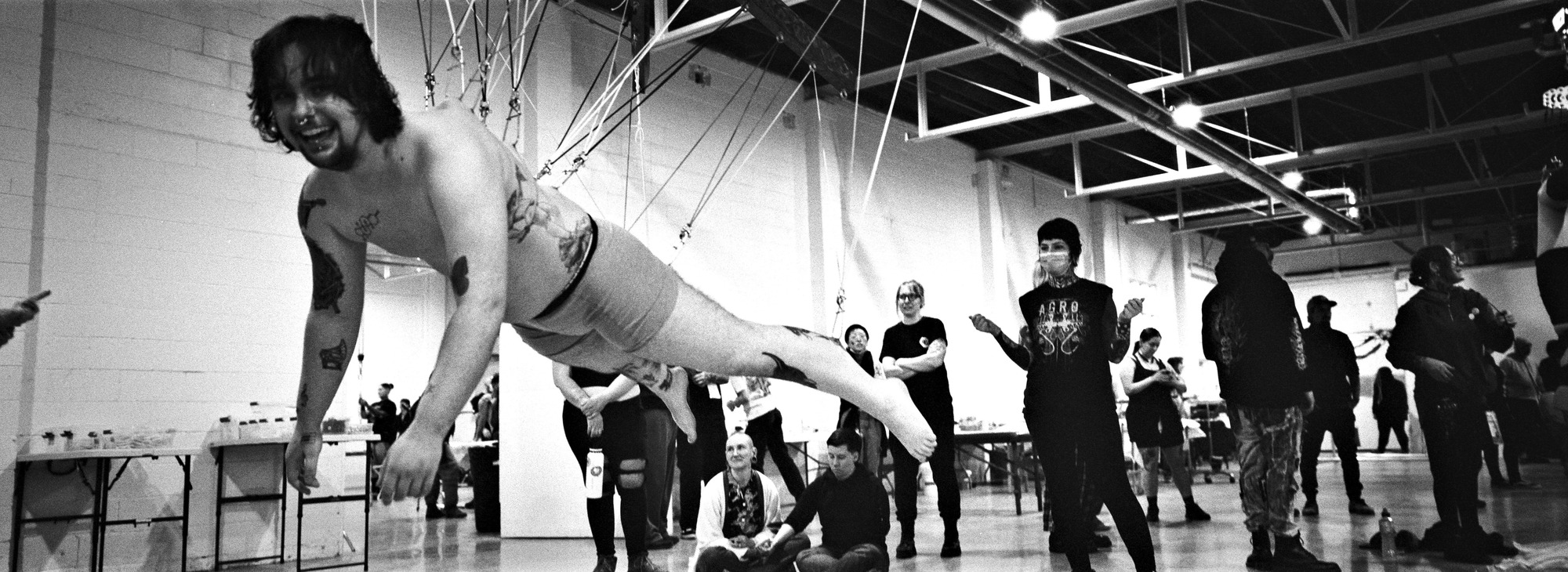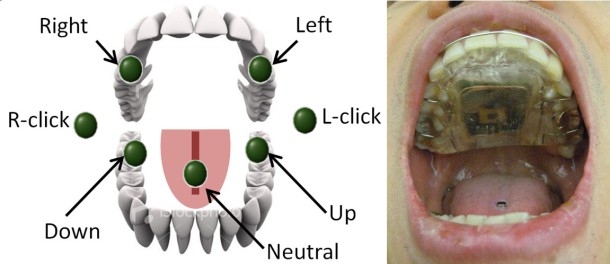Another week has come and gone. The weekend is just about here, but before it can start there’s just one more piece of business left to take care of… the news of the week. After last week’s lengthy catch-up post, this week is is a little light on stories, but it does have some interesting ones.
First up is a story that could be considered a follow-up. I recall a story last year about some scientists who were developing a way for people with spinal cord injuries to move around, using only a tongue stud. Well since then they’ve created a number of test models, and they’re being used in trials right now.
The Tongue Drive System is getting less conspicuous and more capable. Tongue Drive is a wireless device that enables people with high-level spinal cord injuries to operate a computer and maneuver an electrically powered wheelchair simply by moving their tongues. The newest prototype of the system allows users to wear an inconspicuous dental retainer embedded with sensors to control the system. The sensors track the location of a tiny magnet attached to the tongues of users. In earlier versions of the Tongue Drive System, the sensors that track the movement of the magnet on the tongue were mounted on a headset worn by the user. “By moving the sensors inside the mouth, we have created a Tongue Drive System with increased mechanical stability and comfort that is nearly unnoticeable,” said Maysam Ghovanloo, an associate professor in the School of Electrical and Computer Engineering at the Georgia Institute of Technology.
In recent months, Ghovanloo and his team have recruited 11 individuals with high-level spinal cord injuries to test the headset version of the system at the Atlanta-based Shepherd Center and the Rehabilitation Institute of Chicago. Trial participants received a clinical tongue piercing and tongue stud that contained a tiny magnet embedded in the upper ball. They repeated two test sessions per week during a six-week period that assessed their ability to use the Tongue Drive System to operate a computer and navigate an electric wheelchair through an obstacle course. “During the trials, users have been able to learn to use the system, move the computer cursor quicker and with more accuracy, and maneuver through the obstacle course faster and with fewer collisions,” said Ghovanloo. “We expect even better results in the future when trial participants begin to use the intraoral Tongue Drive System on a daily basis.”
How different is a clinical tongue piercing from a normal tongue piercing? Also, it should be noted that Anatometal is contributing to this endeavor, which means that when they do go into production, the jewelry used for the stud will undoubtedly be high quality.
Now a weekly news roundup wouldn’t be complete without some criminal activity, and this week we’ve hit a new low.
Police said a man traded tattoos, piercings and marijuana with at least five teenage girls in exchange for nude photos. The father of two of the girls said his daughters met Ford through a mutual friend. He told Channel 11′s Timyka Artist that Ford would leave cash under a rock for the girls after they sent him the photos. Other times he would pierce and tattoo them. The girls’ father, who did not want to be identified, said his daughters are now being tested because he suspects that Ford reused needles. “It was never in a professional place, always some seedy situation,” he said.
Allegheny County police said the five teenage victims are from Brentwood Middle School between the ages of 12 and 14 years old.
12-14. Something tells me that if this guy is found guilty, he’ll have a lot of friends in prison.
Moving on, 3News from New Zealand has a story about Dr. Reverend who uses a pretty unique medium for his art.. his own blood.
Five years ago the Sydney tattooist, Dr Reverend, was getting regular blood tests because of liver problems when the inspiration to paint with blood struck him for the first time. “The down side was I got such a kick out of it I did another one and thought ‘I wonder if I can run it through an airbrush’,” he says. “I could get my blood to run one of these like paint and after that there was no turning back”.
And so at the Melbourne tattoo convention the doctor took things to their logical extreme and connected an IV line and painted straight from his body.
Here’s a link to the video of the interview, which includes footage of him painting directly from his vein.
While we’re on the subject of blood, The Vancouver Sun has done an extensive feature of scarification, including a video of a scarification in progress.
Women have long gone under the knife for the sake of beauty. A growing trend in body modification, however, is now seeing them do so in the name of art. Unlike tattoos, which use needles to create a permanent design, scarification involves carving patterns into the flesh with a scalpel. And to hear it from industry insiders, an estimated 60 to 70 per cent of those being cut aren’t countercultural thrill-seekers but rather professional women, ages 25 to 50, desiring something more understated than traditional ink. “It can produce the same type of image as a tattoo but it’s a lot more subtle and less aggressive,” says Keith Kennedy, a Calgary scarification artist for the past eight years.
Few scarification artists advertise their services out of fear this “grey area” of body modification will be made illegal in Canada. A handful, however, are working directly with medical and health officials – Calgary’s Kennedy included – to demonstrate that, when done correctly, this unique art form is legitimate and safe. Dr. Mariusz Sapijaszko, past president of the Canadian Society for Dermatologic Surgery, is among the doctors who’ve observed scarification firsthand. “Based on the medical school training that I received, we viewed scarification as a form of self-mutilation rather then body art,” says Sapijaszko, who practices in Edmonton. “(But) I found the scarification artists to be extremely skilled in design, planning and execution of the scarification process. They were meticulous in their technique and obviously had tremendous experience.”
The doctor’s foremost caution is that nobody undertake the process lightly, noting the potential for infection, uneven scarring, keloids (rubbery lesions often accompanied by pain or itchiness) and social embarrassment. “It’s critical that the artist is an expert,” says Sapijaszko. “The results, bad or good, are permanent.”
An in today’s final story, a study by dermatologists at Northwestern University has resulted in 9 steps to prepare your body for a piercing.
To stay safe, the paper describes these points to consider before getting your body pierced.
1. Know your infection risk: If you currently have an infection or an open wound, it’s a good idea to put off the piercing until you are healthy. Risk of infection is higher — especially if the piercer is poorly trained and working in an unsterile environment or using unclean equipment — or if the wound doesn’t heal properly.
2. Be aware of medical issues: If you have health problems, such as poorly controlled diabetes or other conditions that weaken your immune system, your chances of infection are higher and piercing is riskier.
3. Factor in lifestyle. A nose ring when you’re 20 may look cool, but it may not be so hip or accepted at 30 in some workplaces. If you’re planning to remove piercings frequently to conceal them at work or from your family, this may increase your chances of infection. It may also lengthen healing time of newly pierced skin. If you play a contact sport and your piercings are in an area where they might rip or the jewelry can snag on clothing, this may injure the skin.
It goes on, but you get the idea. For most of us, it’s general knowledge (with the exception of the “coolness” factor), however for a lot of people these tips could end up being very helpful. Ideally it’ll encourage people to stop going to mall kiosks to have their lobes pierced with a gun.
Well, that’s it for this week. Have a great weekend, and remember to e-mail me those news stories you come across.



Comments
12 responses to “ModBlog News of the Week: February 24th, 2012”
The touge thing is really cool. I wonder how the permarent version will effect speech and eating.
The touge thing is really cool. I wonder how the permarent version will effect speech and eating.
@Lila: I’d imagine it would be like eating with a retainer or dentures.
@Lila: I’d imagine it would be like eating with a retainer or dentures.
My guess is that the clinical tongue piercing is placed to allow for the most easy use of the tongue stud in relation to the sensors.
The retainer is removable, by the way. It would cause a minor speech impediment, I think, because it looks very thick… buuut on that note it would be COMPLETELY different from dentures. An upper denture is ground out and shaped to be as thin as possible against the palate without compromising strength.
/makes dentures for a living.
Also, Rob, please cite credit for Anatometal for being part of the collaborative tongue-stud-for-mobility project. Barry and his crew are part of something momentous and should be given credit for it.
My guess is that the clinical tongue piercing is placed to allow for the most easy use of the tongue stud in relation to the sensors.
The retainer is removable, by the way. It would cause a minor speech impediment, I think, because it looks very thick… buuut on that note it would be COMPLETELY different from dentures. An upper denture is ground out and shaped to be as thin as possible against the palate without compromising strength.
/makes dentures for a living.
Also, Rob, please cite credit for Anatometal for being part of the collaborative tongue-stud-for-mobility project. Barry and his crew are part of something momentous and should be given credit for it.
I imagine that it would not impede speech by a large margin. I am curious though if someone can talk or eat with the system in place. Since it is tracking the magnet on the tongue, I would think that talking would cause a reaction in the system.
I imagine that it would not impede speech by a large margin. I am curious though if someone can talk or eat with the system in place. Since it is tracking the magnet on the tongue, I would think that talking would cause a reaction in the system.
@Andraealynne: I honestly didn’t know they were involved. I’ll update it right now.
@Andraealynne: I honestly didn’t know they were involved. I’ll update it right now.
I am absolutely amazed at that tongue stud tech! As a social worker, one of the things seen most common with any physical disabilities is the difficulty in moving in a world designed for the able-bodied. It’s going to be very interesting to see how this technology is used in the future and what other uses for it can be found.
Now if only I could afford one of Dr. Reverend’s paintings. That is fascinating and horrifying at the same time. Gotta love it!
I am absolutely amazed at that tongue stud tech! As a social worker, one of the things seen most common with any physical disabilities is the difficulty in moving in a world designed for the able-bodied. It’s going to be very interesting to see how this technology is used in the future and what other uses for it can be found.
Now if only I could afford one of Dr. Reverend’s paintings. That is fascinating and horrifying at the same time. Gotta love it!